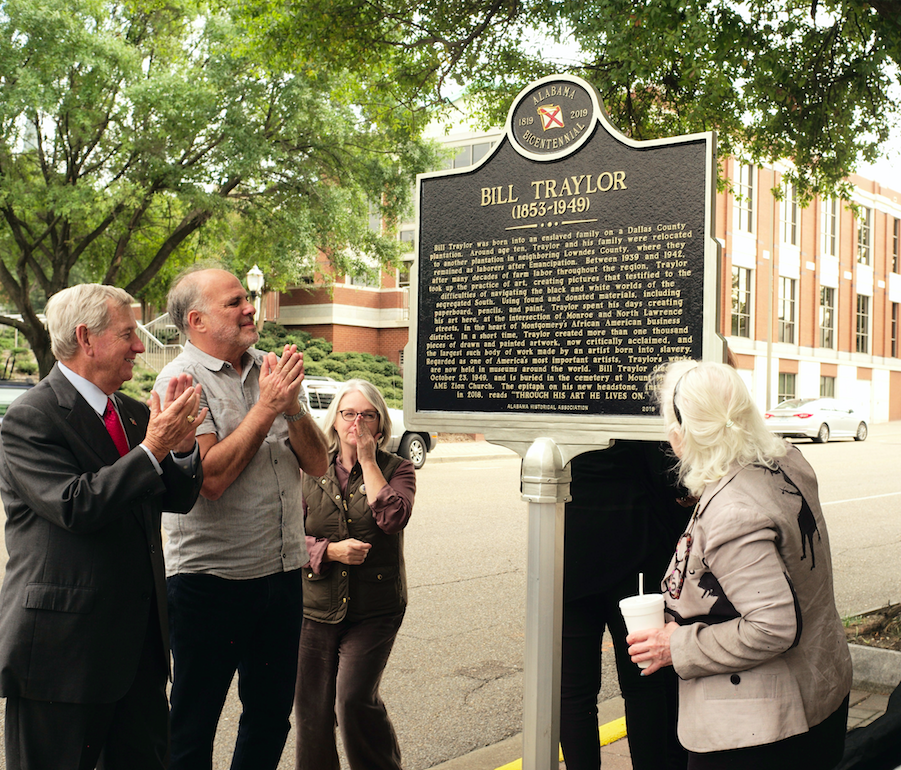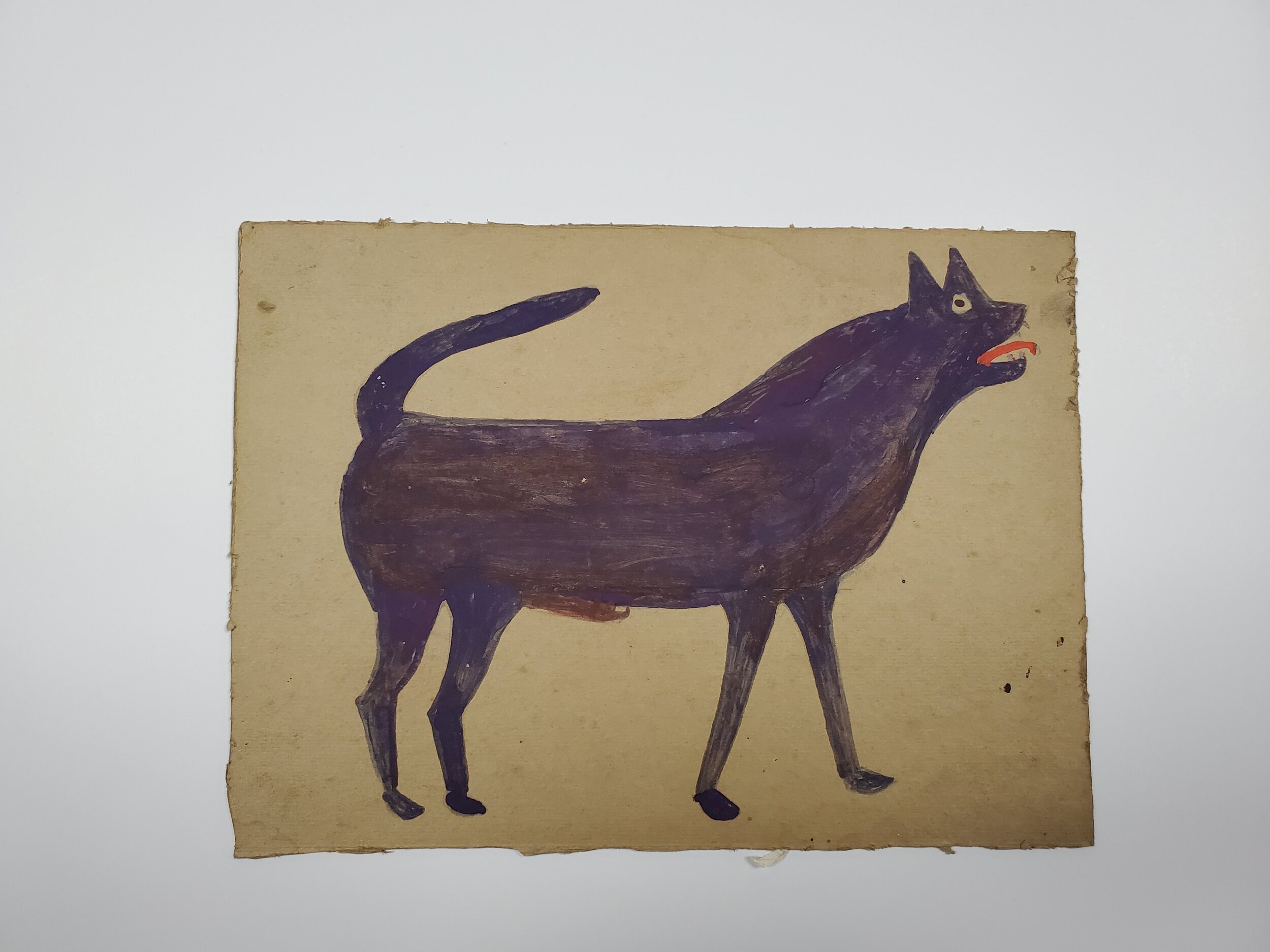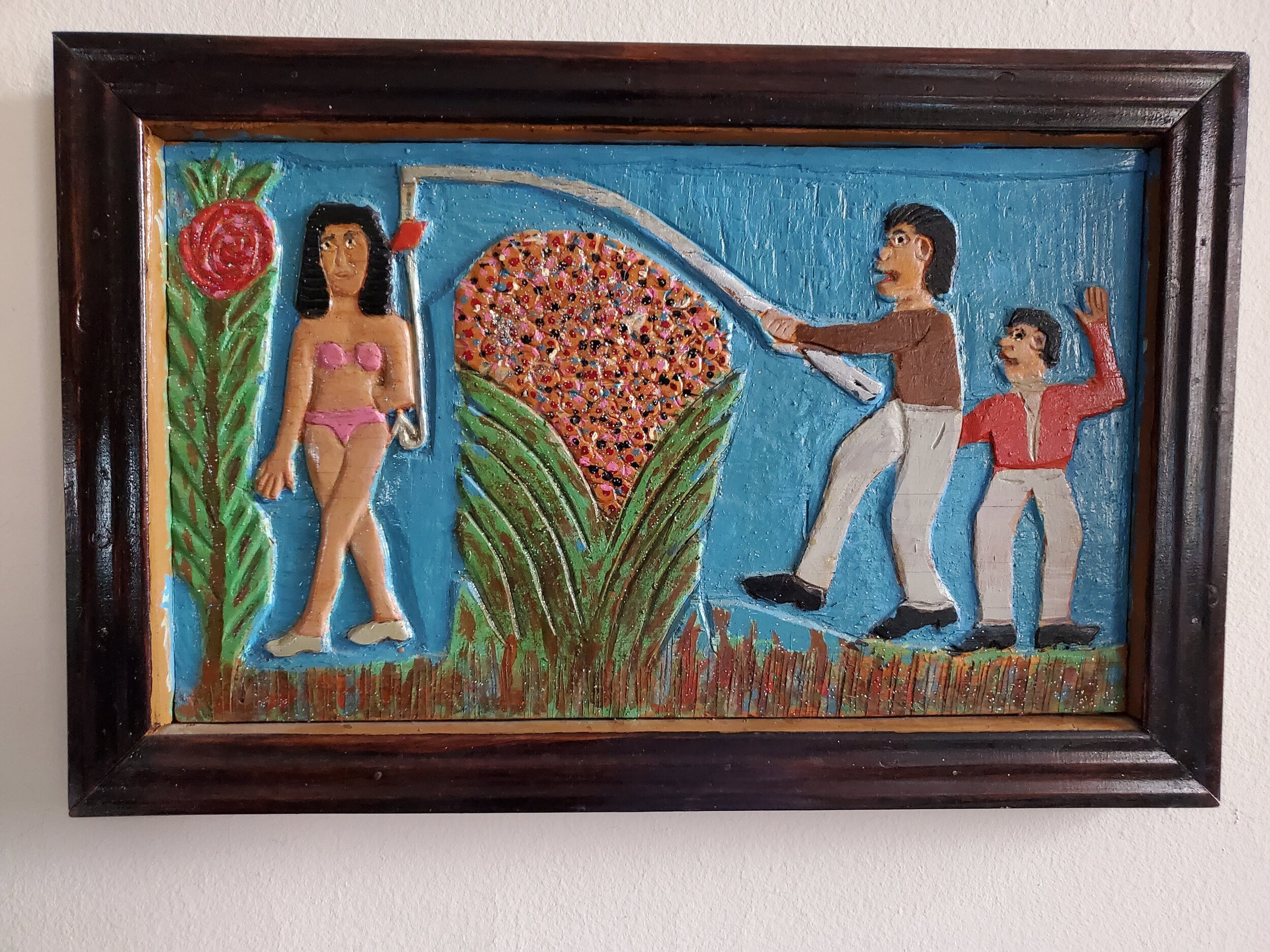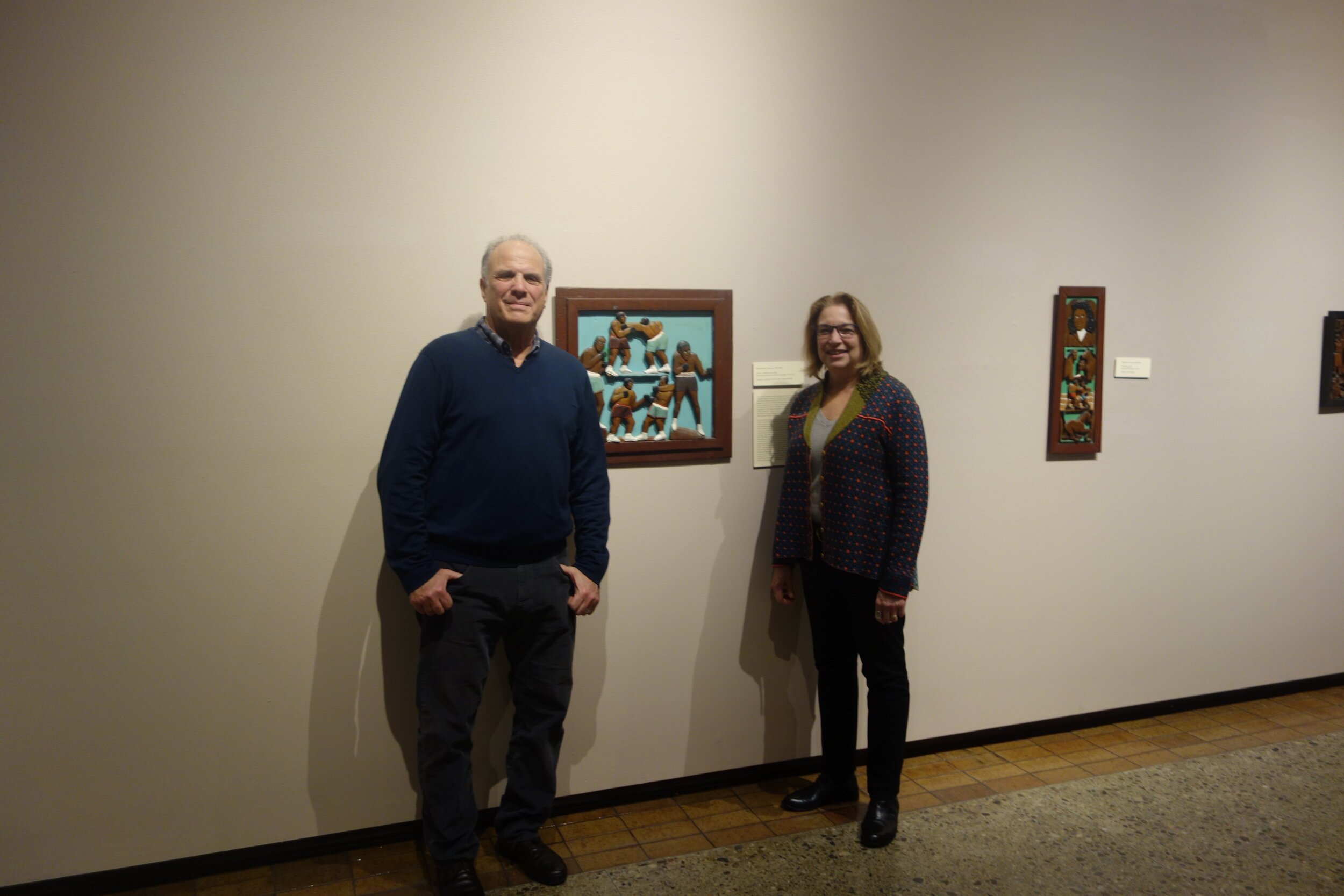Jeffrey Wolf, New York - MEET THE COLLECTOR Series Part Fifty Two
I met Jeffrey Wolf at the Outsider Art Fair in New York, a couple of years back and have since watched his James Castle documentary - I’m still waiting for the Bill Traylor one to come across the seas to the UK. Jeffrey has made a few documentaries where he hopes that he can explore the enormity and complexity of the outsider art field. Read on to find out more from Jeffrey and his friendship with Elijah Pierce in part fifty-two of my ‘Meet the Collector’ series.
Jeffrey Wolf at James Castle: A Retrospective, Philadelphia Museum of Art
1. When did your interest in the field of outsider/folk art begin?
It was in 1971, as a college sophomore, that I first met Elijah Pierce (1892-1984). He was sitting alone in The Ohio State University’s Hopkins Hall Art Gallery surrounded by walls of painted wood-relief carvings. I was a film/photography major, but I often walked through the art building on my way to class. On this day I never made it to class. Pierce spent three hours as my personal guide around the gallery telling me stories of religious parables, personal adventures, American history and other topics that I would ask him to retell on many occasions after that first encounter. From that point on I looked for visual and written material about artists without formal training like Pierce. I came across a catalogue by William A. Fagaly that exposed me to Sister Gertrude Morgan, Bruce Brice and Clementine Hunter.
The writings of Roger Cardinal exposed me to Art Brut and artists outside the United States. Through Phyllis Kind, Jeany and I were introduced to art historian/curator Elka Spoerri, whose husband was part of the Adolf Wölfli discovery. In 1978, we saw his work while still bound in books in the bowels of the Kunstmuseum Bern. On that same trip, the visit to l’Art Brut Museum in Lausanne blew us away.
James Castle hung in Jeffrey’s house
2. When did you become a collector of this art? How many pieces do you think are in your collection now? And do you exhibit any of it on the walls of your home or elsewhere?
We started collecting with the work of Elijah Pierce in the early 1970’s. We aren’t floor to ceiling collectors. Other than a few artists that we had some personal involvement with, Jeany and I tend to collect one or two excellent pieces by any given artist. Though, we still have over 100 pieces in our collection. The work is primarily hung in our NYC apartment but has travelled to many shows both nationally and internationally including, the Moore College of the Arts, Philadelphia Museum of Art, The Corcoran Gallery, The Smithsonian American Art Museum, The Museo Nacional Centro de Arte Reina Sofía, The American Folk Art Museum, The Canton Museum of Art, and most recently the Barnes Foundation.
3. Can you tell us a bit about your background?
Jeany and I grew up with immigrant parents, survivors of the Holocaust. I’m still not clear if this has any influence on our interest in the field or not. Being a first generation American I did feel removed from the mainstream. I always wanted to open people's minds up to new ideas and change. I went to film school and have worked in media, mostly as an editor, and several other disciplines as well. My interests seem to encompass subject matter that leans toward social justice and enlightened behaviour.
Martín Ramírez, Elijah Pierce, Bessie Harvie, Steve Asby, Howard Finster, Miles Carpenter and Russell Gillespie
4. In 2008 you directed a documentary on the outsider artist James Castle titled ‘Portrait of an Artist’ – what led to this change and wanting to create a documentary about an individual artist who was Deaf?
Beginning with the Corcoran Gallery show “Black Folk Art in America: 1930-1980” I felt for the first time there was a movement afoot. The show was a watershed moment. I was already very established in my career and decided I could take time off now and again to make my own films. I even started a foundation to help support this idea. The Foundation for Self Taught American Artists was co-founded with the Philadelphia Museum of Art. Along with the advisory board, we considered a handful of artists as subjects for the first film, and circumstances led me to James Castle.
Deafness was not a factor in the decision at all. It was the art that attracted me to James Castle - the fact that he was deaf is certainly part of his narrative. In fact “Portrait of an Artist” is the perfect title to exemplify Castle’s work and work ethic. He is the purest definition of what an artist is and seemed like a good subject to discuss the enormity and complexity of the field.
5. This has since led on to a documentary on Bill Traylor last year, which is currently being showcased across America. What is it that interests you so much about Traylor and how many years did this documentary take to pull together? I believe you did a kickstarter campaign in order to create this documentary, is that correct? How did it feel to have it premiere at the Smithsonian Bill Traylor exhibit last year?
The film reimagines the way we see and talk about Bill Traylor’s art and his influence on the art world. Making a film about an artist is like curating a show. After eight years of research and editing and on the heels of a successful film festival tour, and a delay due to the Covid 19 outbreak, we are thrilled to announce that The Film Forum, New York’s leading theatre for independent premieres, has offered a two-week calendar engagement for Bill Traylor: Chasing Ghosts for the Spring of 2021. With this commitment, the well-known distributor Kino Lorber has acquired our film and will launch it in other independent theaters throughout North America and on digital platforms. This is a major victory for the film, the field and Bill Traylor himself.
Kickstarter helped us raise the money for one three-day shoot. There were many angels involved in making the film possible from financial to creative support. Most importantly the writing of Fred Barron; the producing of Jeany Nisenholz-Wolf and Daphne McWilliams; the cinematography of Henry Adebonojo; and the editing of Keith Reamer. The Smithsonian American Art Museum and Leslie Umberger, curator of “Between Worlds: The Art of Bill Traylor,” was the most influential collaborator. The screening of the film combined with the awesome show was very rewarding.
Dwight McKintosh, JB Murray, Bill Traylor and others
6. Are there any other artists that you have created documentaries about within this field? Are there reasons why you have chosen certain individuals?
Besides James Castle: Portrait of an Artist and Bill Traylor: Chasing Ghosts I have also made short films about the following artists: James ‘Son Ford’ Thomas, Elijah Pierce, and Gregory Van Maanen. I have raw material to make short films about William Hawkins and Martin Ramirez as well. I’m particularly interested in Ramirez because I’m fascinated by the idea that he, Castle and Traylor all used found materials in three completely different geographical and social settings.
7. What style of work, if any, is of particular interest to you within this field? (for example is it embroidery, drawing, sculpture, and so on)
The materials are not as important to me as the quality, uniqueness and narrative assigned to the work. I want to hear and tell the stories of the artists left out of the cannon of 20th century art.
8. A conflicted term at present, but can you tell us about your opinion of the term outsider art, how you feel about it and if there are any other words that you think we should be using instead?
Those terms have become the brand. When talking to people outside the field it seems to be shorthand. The terms have nothing really to do with the process of making the art. This art can’t just be lumped together as one thing.
Bill Traylor
9. Would you say you had a favourite artist or piece of work within your collection? And why?
I love them all. On different days some more than others. It’s the pieces we don’t own which I always have in my purview - William Hawkins, William Edmondson and Carlo Zinelli.
10. Where would you say you buy most of your work from: a studio, art fairs, exhibitions, auctions, or direct from artists?
All of the above.
11. Is there an exhibition in this field of art that you have felt has been particularly important? And why?
“Folk Sculpture U.S.A” at The Brooklyn Museum was the show that encouraged me to help Elijah Pierce and introduce him to dealers. The Corcoran Gallery “Black Folk Art in America: 1930-1980” was a watershed show. It travelled all around the United States and opened up the field to many then unknown artists. The Smithsonian American Art Museum, “Between Worlds: The Art of Bill Traylor.” This show was the most comprehensive treatment of any of the artists in the field. Also it has a great catalogue.
12. Are there any people within this field that you feel have been particularly important to pave the way for where the field is at now?
Bert Hemphill taught me to write about the works. Harris Diamant taught me about form and surface. Phyllis Kind offered critical thinking that I valued greatly and couldn’t get anywhere else.
Images above: October 25, 2019 unveiling of Historic Marker for Bill Traylor in Montgomery, AL. Former Montgomery mayor Todd Strange, Jeffrey Wolf, Christy Anderson and Judy Saslow. Also a Bill Traylor artwork.
13. You are on the board at the Folk Art Museum in New York – what does this role entail?
It’s actually called The Council for Art Brut and Self-Taught Art. The purpose of this group is to help guide the museum curators in understanding what is important to the museum membership and public at large. I’d like to see the group meet more often.
14. What are you working on at the moment?
I’m interested in the arts and my films will most likely continue in that direction. I would like to address why these works have been left out of the discussion of the history of art in the 20th Century and how we can reimagine or recontextualize the way we see and talk about the influence many self taught artists have had in the contemporary art world at large. That being said I’ve been thinking a lot about Romare Bearden. I think he is a connector between Bill Traylor and certain contemporary African American artists.
Images above: Elijah Pierce, “The Pickup,” and Jeffrey Wolf and Jeany Nisenholz-Wolf standing in front of “Louis vs. Braddock” by Elijah Pierce
15. Is there anything else you would like to add?
I want to make a plea to all your readers to support Bill Traylor: Chasing Ghosts when it comes to a theatre near you. This is a chance to introduce him and expose his work to a broader audience.
Elijah Pierce, Hippo and Lion









